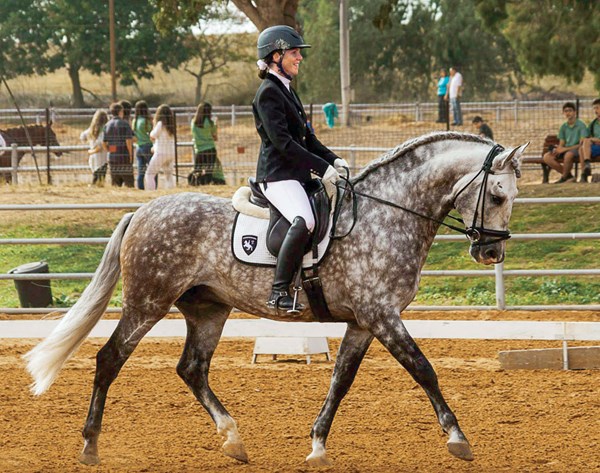In this picture Carmen Deville Makover is showing her young PRE stallion, Quinones Mac (“Q”), in a First Level test. It is evident that the horse is still young, not only because of his darker gray spots, but also because of his muscling.

He has the typical PRE stallion neck but still lacks muscles supporting his topline and back. He looks willing, active and supple but not yet strong enough to carry more weight from behind. It is nice to see he is reaching toward the bit. This breed tends to be talented and bred for collection, but often known to offer it too early, when the horse is not yet strong enough. This picture shows that Q trusts his rider and is lengthening his neck as much as he can while balancing from behind. This is a very nice outline and balance for a First Level test.
To improve further, Q now should strengthen his engine and become stronger and more active behind. This will help him develop the ability to carry more weight while staying balanced and reaching forward in his neck. This was one of Q’s first shows, and Carmen is sitting on him looking very happy and proud of her mount. Her seat is balanced. She is nicely upright and displays the correct ear–shoulder–hip–heel alignment mentioned in the USDF Rulebook. To be picky, I notice that her right hand is carried slightly lower than her left. She could also carry both hands with a little more bend in her elbows.
With her smile, Carmen reveals how much fun performing a test can be. Smiling is not only important to get a little extra bonus point, but it does change many small, automatic things in our bodies. There is a very simple way to feel this. Try this: Sit upright and make a really angry face with hard eyes and a tight mouth. Then feel how much effort it takes to keep your shoulders back and your chest open. An angry face triggers our body to keep our shoulders forward and tense. A smile can significantly change this posture. It feels like a smile on your face continues down into the rest of your body.
In the picture Carmen’s shoulders are correctly aligned, but I would like her to sit more proudly with confidence. Although her seat is correctly positioned, it appears a little passive, like she is just following the horse’s movement. She is not disturbing him, but she is also not yet helping to develop more movement.
To become more effective, I would advise her to try this: Challenge yourself to improve your reaction time within the circle of aids. For example, riding short transitions between walk and trot requires your seat, your abdominal and back muscles to support balance. The same is true for the horse who will have to develop suspension in the transition up to trot and more strength when stepping under and using his hind leg as the brake for the transition to walk. Having your horse push off the ground and step under his own weight trains him in the interplay of his abdominal and back muscles, too. When riding quick transitions, more positive tension will be established, which ultimately helps to develop more quality in the movement. To personally feel this same effect, you can swing your arms slowly next to your body. This is a very relaxing, easy movement. When speeding up the movement, you will automatically need to become more stable within your body to control your hands. Using rhythm and timing between transitions therefore is a great tool to establish more positive tension.
Becoming quicker is one of the keys to success when riding at higher levels. Just watch out: Whenever the tension gets too high you must be able to slow down and release a bit to avoid unwanted tension, resistance or stiffness.
Carmen should aim to become quicker but still allow her smile to shine on through her body and of course, let Q shine with her!
Susanne von Dietze is a leader in equestrian biomechanics. A physiotherapist, licensed Trainer A instructor and judge for dressage and show jumping, she gives lectures and seminars throughout the world, including at the prestigious German Riding Academy in Warendorf. She is a native of Germany and now lives with her husband and three children in Israel, where she competes at the international level. She is the author of two books on the biomechanics of riding: Balance in Movement and Rider and Horse, Back to Back.











